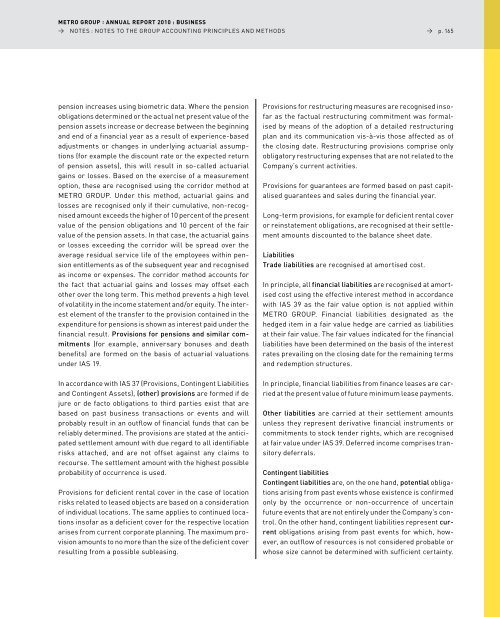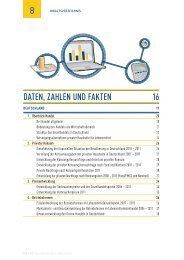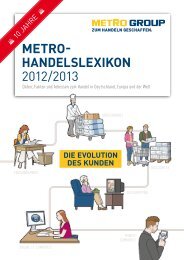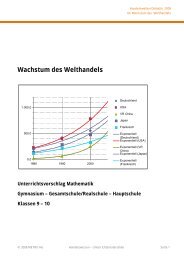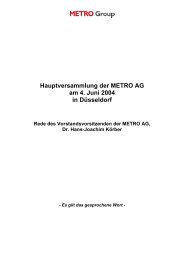pdf (2.5 MB) - METRO Group
pdf (2.5 MB) - METRO Group
pdf (2.5 MB) - METRO Group
Create successful ePaper yourself
Turn your PDF publications into a flip-book with our unique Google optimized e-Paper software.
<strong>METRO</strong> GROUP : ANNUAL REPORT 2010 : BUSINESS<br />
→ NOTES : NOTES TO ThE GROuP ACCOuNTING PRINCIPlES ANd METhOdS<br />
pension increases using biometric data. Where the pension<br />
obligations determined or the actual net present value of the<br />
pension assets increase or decrease between the beginning<br />
and end of a financial year as a result of experience-based<br />
adjustments or changes in underlying actuarial assumptions<br />
(for example the discount rate or the expected return<br />
of pension assets), this will result in so-called actuarial<br />
gains or losses. Based on the exercise of a measurement<br />
option, these are recognised using the corridor method at<br />
<strong>METRO</strong> GROuP. under this method, actuarial gains and<br />
losses are recognised only if their cumulative, non-recognised<br />
amount exceeds the higher of 10 percent of the present<br />
value of the pension obligations and 10 percent of the fair<br />
value of the pension assets. In that case, the actuarial gains<br />
or losses exceeding the corridor will be spread over the<br />
average residual service life of the employees within pension<br />
entitlements as of the subsequent year and recognised<br />
as income or expenses. The corridor method accounts for<br />
the fact that actuarial gains and losses may offset each<br />
other over the long term. This method prevents a high level<br />
of volatility in the income statement and/or equity. The interest<br />
element of the transfer to the provision contained in the<br />
expenditure for pensions is shown as interest paid under the<br />
financial result. Provisions for pensions and similar commitments<br />
(for example, anniversary bonuses and death<br />
benefits) are formed on the basis of actuarial valuations<br />
under IAS 19.<br />
In accordance with IAS 37 (Provisions, Contingent liabilities<br />
and Contingent Assets), (other) provisions are formed if de<br />
jure or de facto obligations to third parties exist that are<br />
based on past business transactions or events and will<br />
probably result in an outflow of financial funds that can be<br />
reliably determined. The provisions are stated at the anticipated<br />
settlement amount with due regard to all identifiable<br />
risks attached, and are not offset against any claims to<br />
recourse. The settlement amount with the highest possible<br />
probability of occurrence is used.<br />
Provisions for deficient rental cover in the case of location<br />
risks related to leased objects are based on a consideration<br />
of individual locations. The same applies to continued locations<br />
insofar as a deficient cover for the respective location<br />
arises from current corporate planning. The maximum provision<br />
amounts to no more than the size of the deficient cover<br />
resulting from a possible subleasing.<br />
→ p. 165<br />
Provisions for restructuring measures are recognised insofar<br />
as the factual restructuring commitment was formalised<br />
by means of the adoption of a detailed restructuring<br />
plan and its communication vis-à-vis those affected as of<br />
the closing date. Restructuring provisions comprise only<br />
obligatory restructuring expenses that are not related to the<br />
Company’s current activities.<br />
Provisions for guarantees are formed based on past capitalised<br />
guarantees and sales during the financial year.<br />
long-term provisions, for example for deficient rental cover<br />
or reinstatement obligations, are recognised at their settlement<br />
amounts discounted to the balance sheet date.<br />
Liabilities<br />
Trade liabilities are recognised at amortised cost.<br />
In principle, all financial liabilities are recognised at amortised<br />
cost using the effective interest method in accordance<br />
with IAS 39 as the fair value option is not applied within<br />
<strong>METRO</strong> GROuP. financial liabilities designated as the<br />
hedged item in a fair value hedge are carried as liabilities<br />
at their fair value. The fair values indicated for the financial<br />
liabilities have been determined on the basis of the interest<br />
rates prevailing on the closing date for the remaining terms<br />
and redemption structures.<br />
In principle, financial liabilities from finance leases are carried<br />
at the present value of future minimum lease payments.<br />
Other liabilities are carried at their settlement amounts<br />
unless they represent derivative financial instruments or<br />
commitments to stock tender rights, which are recognised<br />
at fair value under IAS 39. deferred income comprises transitory<br />
deferrals.<br />
Contingent liabilities<br />
Contingent liabilities are, on the one hand, potential obligations<br />
arising from past events whose existence is confirmed<br />
only by the occurrence or non-occurrence of uncertain<br />
future events that are not entirely under the Company’s control.<br />
On the other hand, contingent liabilities represent current<br />
obligations arising from past events for which, however,<br />
an outflow of resources is not considered probable or<br />
whose size cannot be determined with sufficient certainty.


